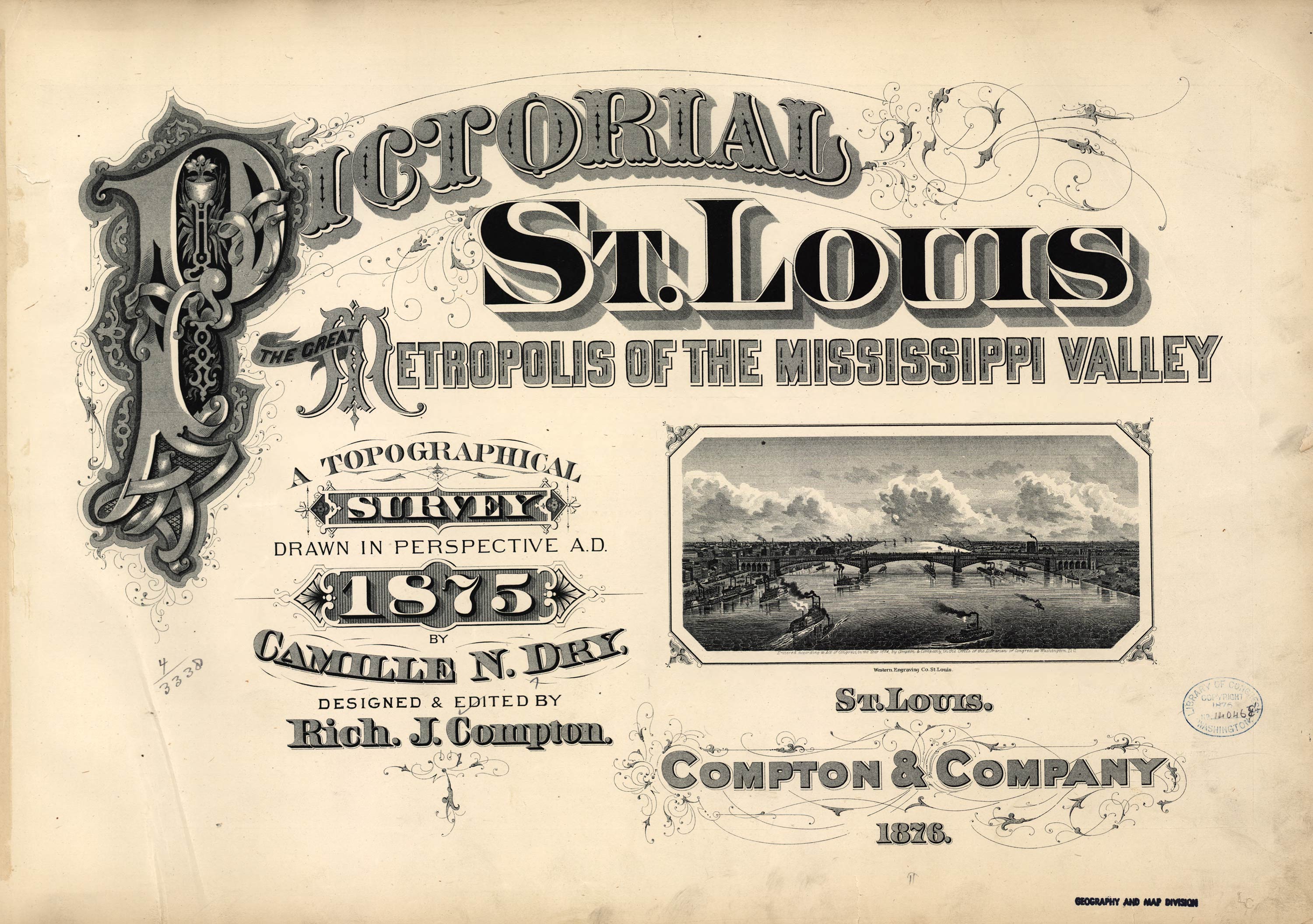

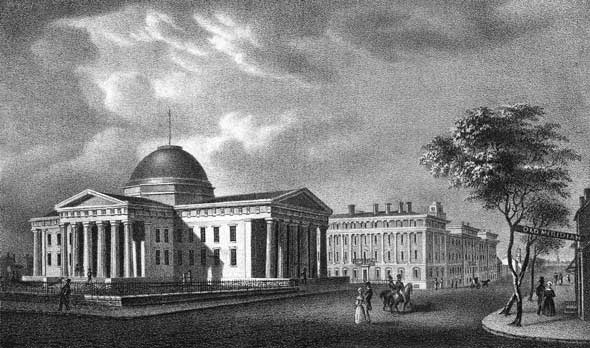
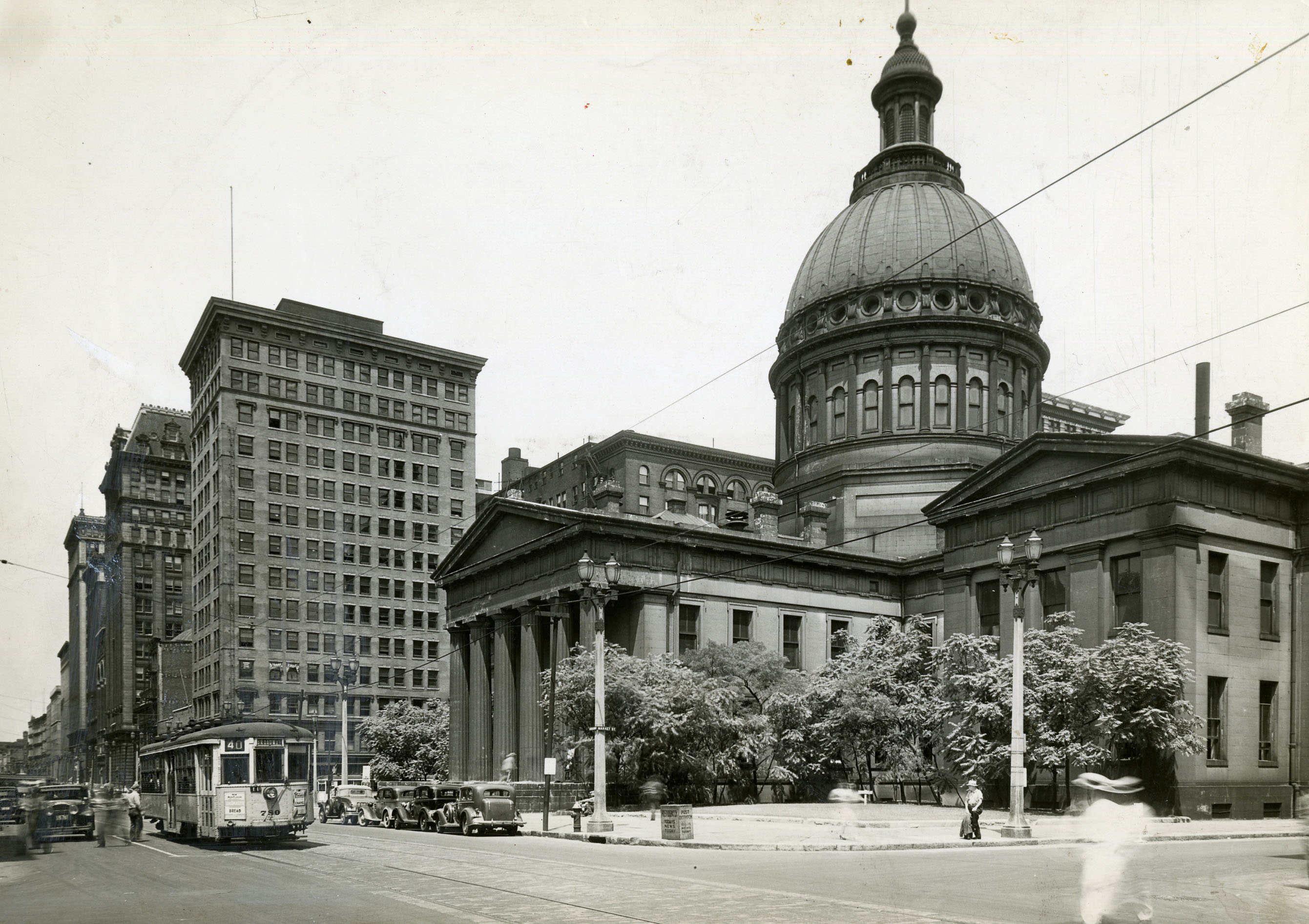
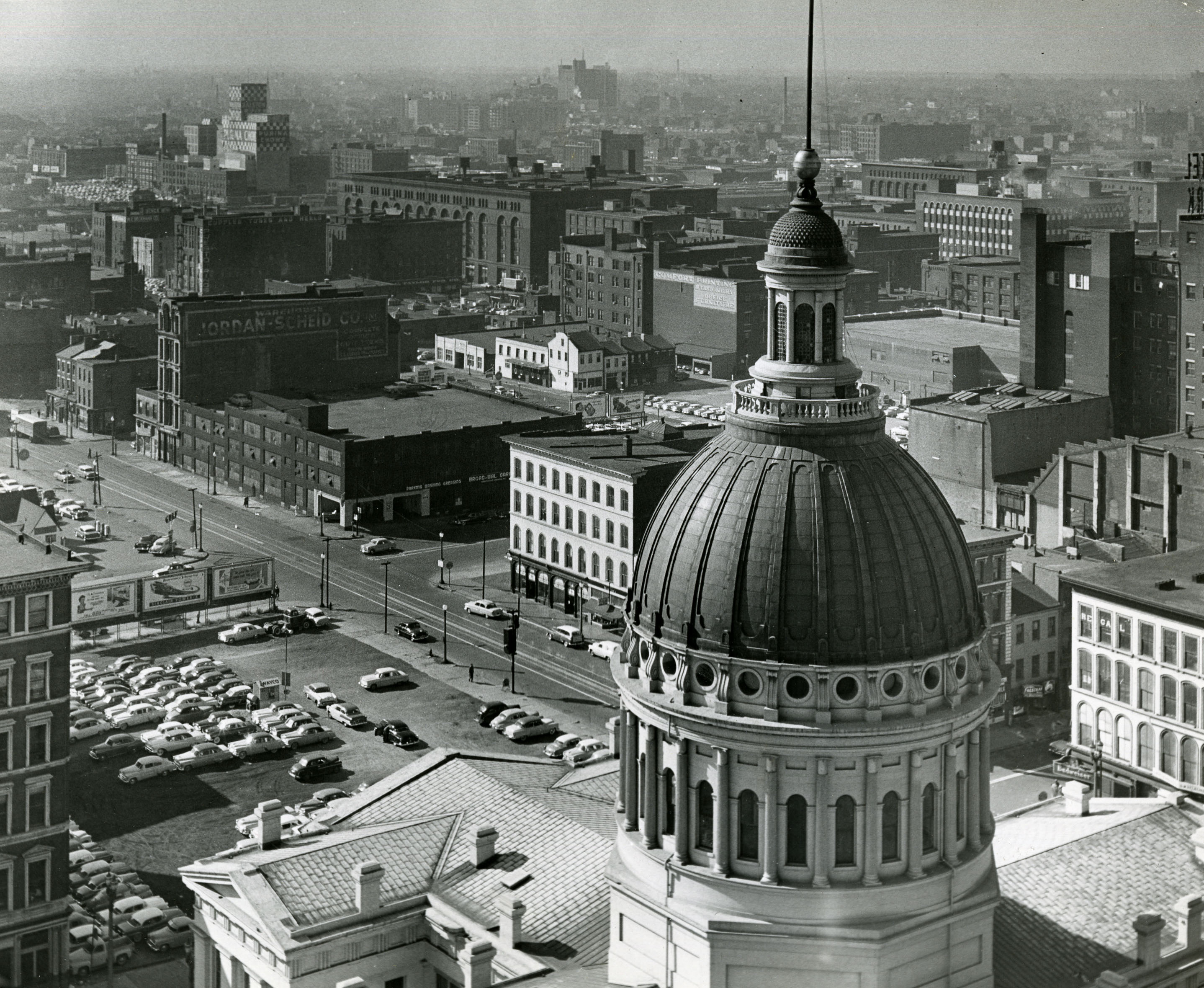
| St. Louis Court House in 1840 from Market and Fourth Streets St. Louis Views Collection |
St. Louis Globe-Democrat August 1935 |
St. Louis Globe-Democrat January 1956 |

Probably no building in the city is so massive and imposing in its general appearance, as the County Court House. Certainly no structure strikes the eye of the passing visitor more forcibly, or more readily commands the attention of the transient stranger. Imposing in appearance, and constructed of massive blocks of hewn limestone, brick and morter, with a magnificent dome, like unto that of St. Paul's, London, crowning its lofty heights, it presents an appearance second to no other public building in the West. Occupying one of the most prominent squares in the city, it is seen from all directions, and is upon all sides, worth of the serious attention of the visitor.
It is built in the form of a Greek Cross ; its four wings resting on Fourth, Fifth, Market, and Chestnut Streets. It is of the purely Doric style of architecture, massive in its proportions, and grand and imposing in its character. The east and west entrances are porticos, supported by gigantic fluted columns of hewn stone, strong enough, seemingly, to last for ages. The basement and first floor are paved with large square blocks of stone, made to last for ever. The interior of the lofty dome is handsomely frescoed, and is much admired as a work of art.
The different circuit courts, the country and probate courts, with the various county offices, are all located in this building and all are handsomely and comfortably furnished.
The history of the St. Louis County Court-House really dates back to December 14, 1812, when an Act of the Legislature was approved entitled : "An Act concerning a Court-House and Jail in St. Louis County." In accordance with provisions of this Act, Thomas Sappington, of Gravois ; Ludwell Bacon, of Bonhomme ; Robert Quarles, of St. Ferdinand ; and Pierre Chouteau, Jr., and William Carr Lane, of St. Louis Township, were appointed commissioners to select a proper site for the buildings, and also authorized to accept donations of land for this purpose. The present site was donated by John B. C. Lucas and Augustus Chouteau, the date of the report of the commissioners being August 25, 1823.
The first steps taken by the country court to put in practice the provisions of the Act was in 1825, the justices then being Joseph V. Garnier, Peter Ferguson, and Francis Nash. In 1833, a building costing $14,000 was completed and occupied, which was the first court-house of St. Louis County.
This, however, soon proved inadequate to the wants of the growing city. The commencement of the present court-house was made in 1838, when Henry Singleton submitted plans and specifications for the "erection of a court-house on the public square," and which were accepted.
The carpenter work was done by Mr. Singleton and Joseph Foster ; the cut-stone work, by James L. Hall. The work slowly progressed until 1831, when Robert S. Mitchell was appointed architect and superintendent, who immediately demolished the old building on the east wing. Mr. Mitchell was succeeded in office by Thomas D. O. Lanham, who in turn was succeeded by William Rumbold as superintendent, after the establishment of the county court in 1859, and the establishment of the board of county commissioners. The dome, as it now exists, was the design of Mr. Rumbold, and is made of cast iron, and was built by Mr. James McPheters. During all these changes in office, additions were being made constantly to the main building, until in July 1862, after a lapse of a quarter of a century, the court-house, as it now stands, was completed, at a total cost of $1,199,871.91. All citizens who delight in the embellishment of St. Louis, point with pride to this magnificent buildings as an honor to the city, not alone for the beauty displayed in its architectural design, but as one of the most imposing and magnificent structures west of the Mississippi.

Pictorial St. Louis

Located in the basement of the east wing of the Court House, was the conception of its present proprietor, Major Henry W. Williams, who commenced thirty years ago, who was the pioneer in this line, and whose work is unsurpassed by anything in the United States for its magnitude, and for the facility with which all real estate transactions nay be traced. Educated originally as a merchant, and having passed through every experience of eight years of mercantile life, Major Williams abandoned that vocation, and, after a regular course of legal studies, was, in 1840, admitted to practice in all the courts of Michigan, and the United States Courts of that State, in which, with his partner, Hon. William T, Mitchell, now of Port Huron, Michigan, he was successfully engaged until the fall of 1844, when he came to St. Louis.
Being unknown in this city, he obtained temporary employment in the County Recorder's Office, and while so employed perceived the necessity that existed for an index to the records that would facilitate the examination of titles. His experience in mercantile life suggested to him the plan of a " Ledger Index," and having fully matured the same he determined to abandon the general practice of his profession, complete, the index which he contemplated, and devote himself exclusively to the examination of titles and conveyancing. The work was commenced in 1845, was prosecuted with untiring energy and zeal until completed, and has been constantly kept up to the present time. Some idea of the magnitude of the work, and of the facilities possessed by the ST. LOUIS TITLE OFFICE, for examining titles with accuracy and dispatch, may be obtained from the following facts: The Ledger Index referred. to fills ninety-six large volumes (record size), and contains reference to every real estate transaction that appears of record from the year 1766 to the present date, covering a period of one hundred and nine years. It is so arranged that, in less than one minute of time, reference can be made to the pages in which are recorded all the real estate transactions of every person who has ever held real estate in St. Louis City or County. It is not like the present public index to the records of this county, or like the printed public index which is now in progress, a mere reference to the book and page with names of grantor or grantee, but gives, in addition, the date of the instrument, the date when filed, and a description of the property conveyed. It is kept constantly posted up from full abstracts of the deeds, etc., which are made daily, as soon as they are filed in the Recorder's Office. The advantages of this system are- First, the facility which it aOords for ascertaining at a glance the deeds by which property has been transferred; Second, the accuracy which it insures, it being impossible, without clilpable negligence, to overlook conveyances or encumbrances. Another advantage of the system is that it may be continued perpetually simply by the addition of new volumes as may be required. When the work was commenced there were less than eighty volumes in the Recorder's Office. Now there are five hundred and thirty-eight voluines, yet the same set of books with which the work was commenced in 1845 has been continued without change or break in continuity to the present time. If continued a thousand years, it will require only the addition of new volumes. The aggregate labor bestowed upon the work is equal to the labor of one man for two hundred and forty years.
The abstracts of deeds, which are made when filed in the Recorder's Office, after havinO' been posted into the LedO'er . b b Index in the respective accounts of the parties thereto, are transferred to their proper places in the same order as they appear of record, and thus the St. Louis Title Office has become a miniature Recorder's Office, where may be found all the information which the County Records afford , and the proprietor makes up the chains of title from his own records, going to the Recorder's Office only for the purpose of determining whether the deeds referred to in the chain of titie which he is examining are in proper and legal for'm and duly acknowledged to pass the title.
In addition to the abstracts of all the deeds from 1804 to the present time, the office has full abstracts of all the Archives above referred to, and all the" confirmations" which have been made by the Old Board of Commissioners; the Recorders of Land Titles, Bates and Hunt; the Late Board of Commissioners, etc.; also, a " Tract Book," which exhibits all the" Entries" of land in St. Louis County, as made at the Land Office of the District, and connected with this there is an Alphabetical Index, and also a Plat Index, showing by whom all entries have been made, and to whom all tracts of land have been granted or confirmed, the same being also entered in the Ledger Index. The inception of the title, as derived from the United States, can thereby be ascertained in a few moments, and by the Ledger Index the same can be traced to the present time with great dispatch and accuracy.
In addition to these facilities for tracing titles, the St, Louis Title Office has plats and surveys of every tract or lot of grollnd in the city and county. One series of plats contains all the blocks of the city as it existetl in 1847, with the names of the owners and the parties then in possession of each lot, verified by the proprietor in person while discharging the duties of County Assessor, which he undertook for the sole purpose of perfecting and verifying said plats. Another series contains all the blocks of the city as it existed in 1859 anu 1860, made in a similar manner, showing the names of owners and parties in possession at that period. Another series of plats exhibits all the iots and tracts in both city and county with the names of owners in 1864 and 1865. Another series of plats, contained ill nine large volumes, embraces every addition to the city and every subdivision of lots or lands in the city and county, as they appea!" of record in the County Recorder's Office. Another series of plats, numbering nearly nine hundred, exhibit the Common Field Lots and Commons, and other large bodies of land, according to the Government Surveys thereof, and all conflicting surveys, showing also the original subdivisions of said tracts, and how they are at present subdivided. These plats show a vast amount of labor, and great care has manifestly been taken in their construction to secure accuracy.
Copies of all the abstracts and chains of title which have been made at this office for the last thirty years have been retained, and fill six large cases, so arranged that reference can be made at once to any of them. They embrace the chain of title to nearly every lot or tract of land in the city and county, and among them several important and laborious investigations, especially the examination and report upon the title of the city to the St. Louis Commons, a tract embracing 45 IO arpens, and also the numerous surveys conflicting therewith, which was made in 1854, and which settled the question of title to all the land embraced in the extensive sales made by the city in the years 1854 and r855; also, the report which was made in 1866 upon the Wharf Property, embracing every lot or tract having a rjver front, from the northern to the southern limits of the city, and giving a full chain of title to each, from the original grant or concession to that date.
Connected with the Office is a valuable Real Estate Law Library, which embraces all the French and Spanish laws bearing upon land titles; all standard works on Real Property; all the Session Acts and General Laws of Missouri from 1804 (when the laws for the District of Louisiana, embracing Missollri, were euacted by the Governor and Judges of the Indiana Territory) to the present year; all the Reports of the Supreme Court of Missouri, and of the Supreme Court of the United States (whi-:h cover all decisions aflecting titles to lands in Missouri that have been made) ; all the laws of the United States and the compilations relating to public lands; also, every work on conveyancing extant, from Sheppard's Touchstone to the present ti me j also a very valuable collection (numbering fifteen volumes) of briefs, arguments, etc., in land suits, collected during the past thirty years, embodying a complete history of land controversies during that period. In all its appointments the Office is complete, and the transaction of its business is systematic and thor~ugh.
To Major Williams there is due very high credit for originating and perfecting a work so important in all its bearings upon every permanent interest. It is rare, indeed, that a city finds a man who conceives of a complete system entirely adequate for its purposes in anyone of its departments, but it is rarer still that he possesses that other faculty which executes the design and puts it in full operation. Major "Williams, as we see, bad the business ability and training to seize upon the proper expedients, and also the legal acumen, the ingenuity, and the application to perfect a system, the v~llle of which grows more and more apparent as the records accumulate. In the light of his careful, scholarly, conscientious labor, the labyrinth through which titles would otherwise he traced is now a plain and luminolls path. A vast amount of work has been performed by him, but it is small in comparison _with the labor he has saved to others.

Pictorial St. Louis
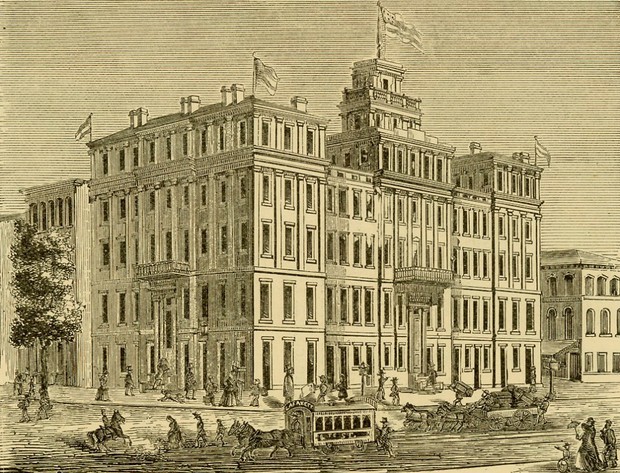
| The second Planters' House Hotel in St. Louis built in 1841, burned down in 1887 |
The second Planters' House Hotel in 1874 after additional floors were added Emil Boehl collection |
The third Planters' House Hotel built 1891, demolished 1976 Emil Boehl collection |

It is rare indeed, that a large building, especially a hotel, passes through successive stages of a city's growth, and yet retains its prestige, as has the "Planters' House." When the foundation, of the hotel were laid, as also when it was opened to the public—the first house ever built in St. Louis which had any pretensions to being more than a cabin—the mansion of Col. Auguste Chouteau was yet standing in all the glory of its quaint embellishment. The Planters' House is now the only considerable structure binding together the past and the present, and serving its original purpose as well as when first built. Other more highly finished hotels have since been erected, as have also a few more spacious, but the Planters' has not yet been brought down from the position of a first-class house, nor has the warm feeling it has in spired by the entertainment of two generations died out in the hearts of the people of the southwest. Charles Dickens, who was once entertained there, railed at the style of its architecture in his American Notes: but, Englishman that he was , he had no word of criticism for the dinners he ate there. Less brilliant people, who were at the same time fairer critics than Charles Dickens, have seen proper to commend both dinners and architecture, during the last thirty-five years, more or less; and have given the spacious old house a peculiar fame enjoyed by no other hotel in the city.
The Planters' House was built by a company incorporated in 1837, the names of the incorporators being Wm. Carr Lane, Pierre Chouteau,]r. (father of Charles Chouteau), David B. Hill, Edward Tracy, John Kerr, J. G. Laveille, anti Joseph Charless. The architect was Henry Spence, and the foundation was laid in the spring of 1837. The brick walls were laid up twice the thickness that would now be thought sufficient but an old-fashioned idea existed at that time that it was well to build for durability as well as for show, and so the extra brick went in. Before the house was completed, it was leased by Stickney & Knight, then keeping the National Hotel at the corner of Third and Market Streets. In April, 1841. the edifice was completed, and was opened with manifestations of great joy on the part of the people, who could but feel gratified that they had then in their own city the most considerable hotel building in the whole West.
The house extends 230 feet along Fourth Street, from Chestnut to Pine, runs back 125 feet in depth, and is four stories and an attic in height. Even now, after fine modern buildings have been put up on every side of it, it does not seem to have fallen behind its surroundings, but rather to have brought them up to itself.
Only about four months after the opening of the house, Mr. Ben. Stickney bought out his partner's interest and ran it alone for five years, until he took in one of his clerks, Mr. Scollay, as a partner. Mr. Scollay died in 1859, when Mr. Stickney ran the house alone until the spring of 1864, when he left it. Mr. Stickney had been proprietor in the same house for twenty-three years, and a host in St. Louis for twenty-seven years. In the first half of the period in which he had kept the "Planters," there had been no aid to travel by railroads, yet the patronage was large from the southern people passing east by way of the Ohio, or up the Illinois River and across to the lakes at the beginning of summer, and back again in the fall. The patronage of the city was also large, and as it was the centre of festivity, the elite of that day were frequently gathered for social enjoyment in its parlors and halls. There are many now, whose heads are white, who will tell of those times and those gatherings, with a sigh for the bygones that have, perhaps, become brighter as they have drifted further away. There are no doubt many yet who, hale and hearty as Mr. Stickney, will remember the "Planters' House Club," where the grace and wit and beauty of the grandmammas of to-day lent an enchantment rarer than anything in the present for them.
When Mr. Stickney retired in 1864, two of his former clerks, Messrs Felt & Hatch continued it for a year, when they went into the old Lindell. They were succeeded by Fogg & Sparr, and the latter by Kelsey & Sparr, who continued for five years, or until 1875, when, in May, Ben. Stickney, Jr., bought the interest of Mr. Sparr, and the firm became, as it is now' Kelsey & Stickney.
There was at one time, about 1854, a project for building up the entire block on which the "Planters' " stands, uniform in hight with the present building, the first floors to be used as stores, and the rooms above as a part of the hotel, with bridges thrown across the court connecting the floors east and west. The Court House, on the south, gives a wide view and a scarcely interrupted breeze from the south, and no changes are liable to take place in that direction. It is also the centre of the various railroad offices, and the new Chamber of commerce is only half a block distant on the east
When Mr. Kelsey became a proprietor, he had gained an enviable reputation as a hotel man in the American Hotel of Columbus, Ohio, the resort of the celebrities who visited the capital of the Buckeye State. In his transplanting himself to St. Louis, the metropolis of the West has been largely a gainer, as no stranger can gain a good idea of the city unless he has a solid basis in good hotel entertainment to commence with.
As before said, the Planters' has rivals larger and finer, with more lofty corridors and greater ornament of interior, but it has a wealth of associations, and liberality of management, that keep it in the front with its more showy competitors.

Pictorial St. Louis

MR. GEORGE I. BARNETT has for many years been regarded as the foremost architect in St. Louis, and enjoys a very large and lucrative business. He was born in Nottingham, England, about sixty years ago, his father being a well-to-do clergyman of good education and refinement. He received an excellent English education, and at fifteen was placed in one of the largest building and architectural establishments in that part of the kingdom, where he learned, not only designing, drawing, and other things pertaining to architecture, but gained a practical knowledge of the building business. The gentleman who first instructed him in the business and afterward employed him, are still living, at a very advanced age, and frequently send kind inquires concerning him. Receiving a small sum of money from his father, Mr. Barnett started out to seek his fortune. he came to America in 1839, and started from New York to go west, not knowing where he would stop. He came as far as St. Louis, and, liking the place, concluded to settle here. Skillful architects were scarce then, and when it was found out that Mr. Barnett was master of the building business in all its branches, his services were in demand. He was not long in becoming intimately acquainted with many of the best citizens, and in a short time opened an office. From that time to the present—a period of thirty-six years—he has never been idle, and frequently has had more to do than he could attend to. Among the many buildings which he has designed and superintend, the following are the most prominent: the old Merchant's Exchange, on Main Street; the Southern Hotel; the Lindell Hotel; the building of the St. Louis Life Insurance Company, at sixth and Locust Streets; Jaccard's building, Fifth and Olive; Insurance Exchange, Fifth and Olive; Barnum's Hotel; De Bar's Grand Opera House, on Market Street; the County Poor House; the Water Works buildings; the residence of the late J. B. Sickles, now occupied by Hon. Thomas Allen; Col. Thomas T. Gantt's residence; Mrs. O'Fallon's residence, on Pine Street; Col. John Knapp's residence on Pine Street; the residence of Napoleon Mullikin, on Grand Avenue; and Charles H. Pecks residence on Grand Avenue.

Pictorial St. Louis

MR. CHARLES K. RAMSEY was reared and educated in St. Louis, and commenced the study of designing and drawing here, but resided for some time in Paris, where he studied the beat authorities on architecture, and examined many of the public buildings of Europe. He commenced the profession of an architect in this city in 1871. The principal buildings which he has built are: the Central Presbyterian Church, corner of Lucas and Garrison Avenues; Dr. Leete's residence, on Washington Avenue, between Ewing and Garrison Avenues; four large houses on Washington Avenue, between Jefferson Avenue and Beaumont Street, for Mr. Robert Anderson; two large houses on Locust street, between Twenty-Third street and Jefferson Avenue, belonging to Mr. Dan. Catlin; and the elegant residences, just completed, for Eben Richards, Esq., on Grand Avenue, near Franklin Avenue.

Pictorial St. Louis

FRED. WM. RAEDER.—This gentleman was born in Coblentz, on the Rhine, in Prussia, in 1832. After graduating from the Prussian Lyceum, he devoted five years to the study of architecture and engineering at Darmstadt, Carlsruhe, and Berlin. Shortly afterwards he came to the United States, and in the spring of 1854, was engaged with the architects of Crystal Palace, New York, remaining with them until the work was completed. Subsequently Mr. Raeder was engaged as topographical and constructing engineer for several railroads. He has been a resident of St. Louis since 1867, and has constructed many important buildings. Among them are the following: He was architect for the St. Louis Board of Public Schools, from 1871 to 1873, and erected eight or nine houses, the most important of which were the Peabody School and the Henry Ames School—models of school architecture; the Washington University Extension; the Church of the Unity, on Park Avenue, near Layfayette Park; the Congregational Church, at Webster Groves; St. John's Episcopal Church, corner Hickory and Dolman Streets; the Episcopal Orphan Home, on Grand Avenue; the Westminster Presbyterian Church; Peper's Tobacco Factory, corner Main and Morgan Streets. Besides this, Mr. Raeder is architect for the Lafayette BuildIng Association; has been elected professor of the department of architecture for Washington University, and will give a portion of his time to the duties of this position as soon as the chair is endowed.

Pictorial St. Louis

MAJOR FRANCIS D. LEE.—This gentleman is a native of South Carolina, having been born in the city of Charleston, in 1826. After graduating at Charleston College, he commenced the study of architecture and engineering, and a year or two after commenced business. He pursued his profession in the city of Charleston until the commencement of the civil war, when his services as an engineer were required by the Confederate Government. He was attached to the staff of General Beauregard, but had command especially of the coast defenses along the coast of the Carolinas and Georgia. He constructed most of the batteries on the coast of North and South Carolina, and was the inventor of the torpedo boat system now generally used throughout the world. Its efficiency was first exhibited against the ironclads "Ironsides" and "Housatonic." At the close of the war Major Lee was invited to France by the Emperor Napoleon III., and had the honor of being presented to his Majesty in person, to whom he explained his inventions and their uses. He was also invited before the lords of admiralty in London, and made them acquainted with the torpedo system. Major Lee has since been invited to join the service of the Pacha of Egypt, and also that of the Government of Buenos Ayres, both of which he declined. For the past nine years he has actively followed the profession of architecture, and has contributed largely toward the architectural beauty of St. Louis. His principal works are the new Chamber of Commerce [see Plate 1], on Third Street, between Pine and Chestnut, a marvel of beauty and symmetry; Mrs. Hunt's building, Fourth and Olive Streets; the Third National Bank, on Olive Street, between Third and Fourth; Hoyle'S building, on Fourth and Elm Streets; Colonel Charles L. Hunt's building, on Fourth Street, opposite the Planters' House; John L. Furguson's building, Fifth and Pine Streets; Bradford & Martin's building, on Washington Avenue and Sixth Street; Wetzel's building, on Main Street, etc.

Pictorial St. Louis
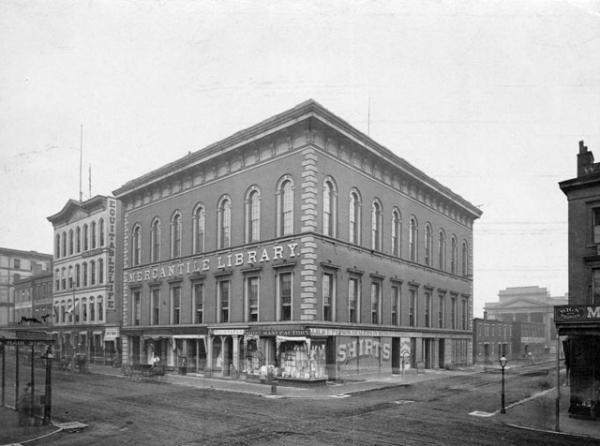
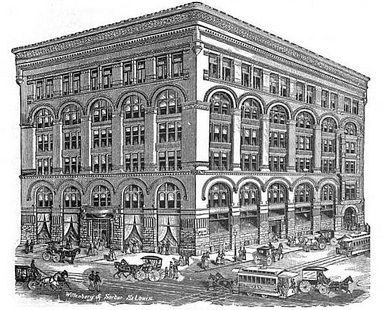
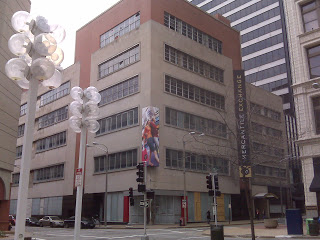
| The Mercantile's first building constructed in the 1850s |
The Mercantile's second building constructed in the 1890s |
The Mercantile's second building given a new facade in 1956 |

[The Mercantile Library] Is an unpretentious three-story brick building. with limestone facings. On Fifth Street it extends 115 feet, and on Locust Street 138 feet. The entire first floor is occupied by stores and the approaches to the library and reading rooms, which are on the second floor. On the topmost floor is the grand hall, the largest in the city. It is 106 by 80 feet in length and depth; and in height measures 35 feet, hence containing 296,800 cubic feet of air. Its seating capacity is 1,600.
In the library are 43,000 volumes, and in the reading room 200 newspapers from all parts of the world and 150 magazines and reviews. The membership is 4,400, and the daily readers average 800. The number of books drawn each day fluctuates from 500 to 1,500. Through the building are scattered works of art, prominent among which may be mentioned a sculptured slab of marble from Nineveh, with a translation of the cuneiform inscription by Prof. Merrill, of Andover, Mass. ; Harriet Hosmer's well-known masterpieces in sculpture, Beatrice Cenci and Œnone; the originals of Bingham's widely copied paintings, the Jolly Flatboatmen, Announcing the Vote, the Election and the Stump Speaking, and Wm. Brodie's busts of Scott and Burns.
The project of starting the Library originated with Mr. John C. Tevis, and in his counting room on Main Street eight citizens set the ball rolling on December 30, 1846. Rooms were rented at Pine and Main Streets, until 1855, when the present building was completed and occupied by the Library Stock Association, etc.
The present president, Mr. Saml. M. Dodd, a liberal patron of the works of art and a respecter of books, brings a peculiar aptitude to the position which he has for some time held.
The actuary and librarian, Mr. Jno. N. Dyer, has held that position for many years. The satisfaction which he has given is evinced by the long term of his continuous services.

Pictorial St. Louis
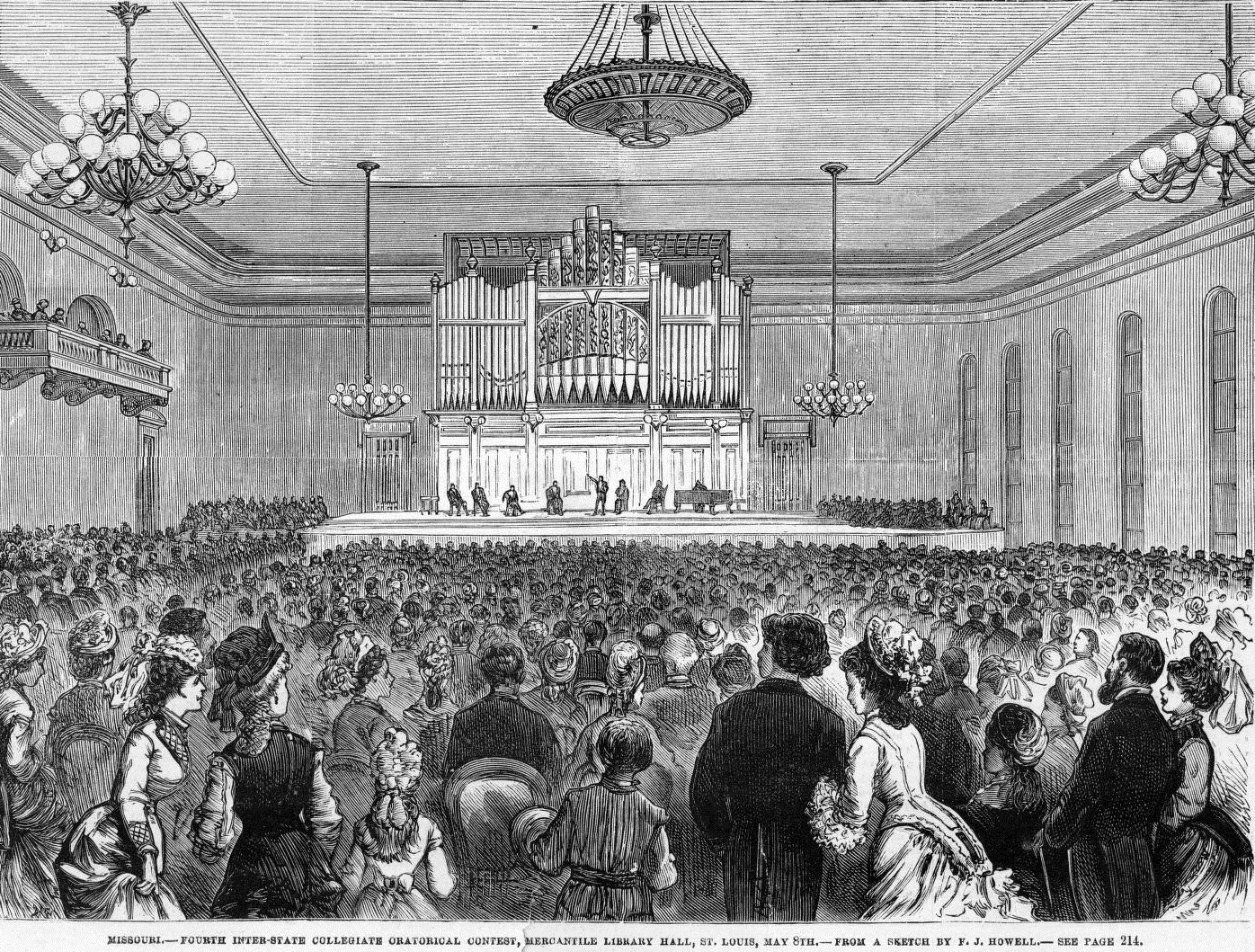
| The Mercantile Library Hall in 1878, from Frank Leslie's Illustrated Newspaper |
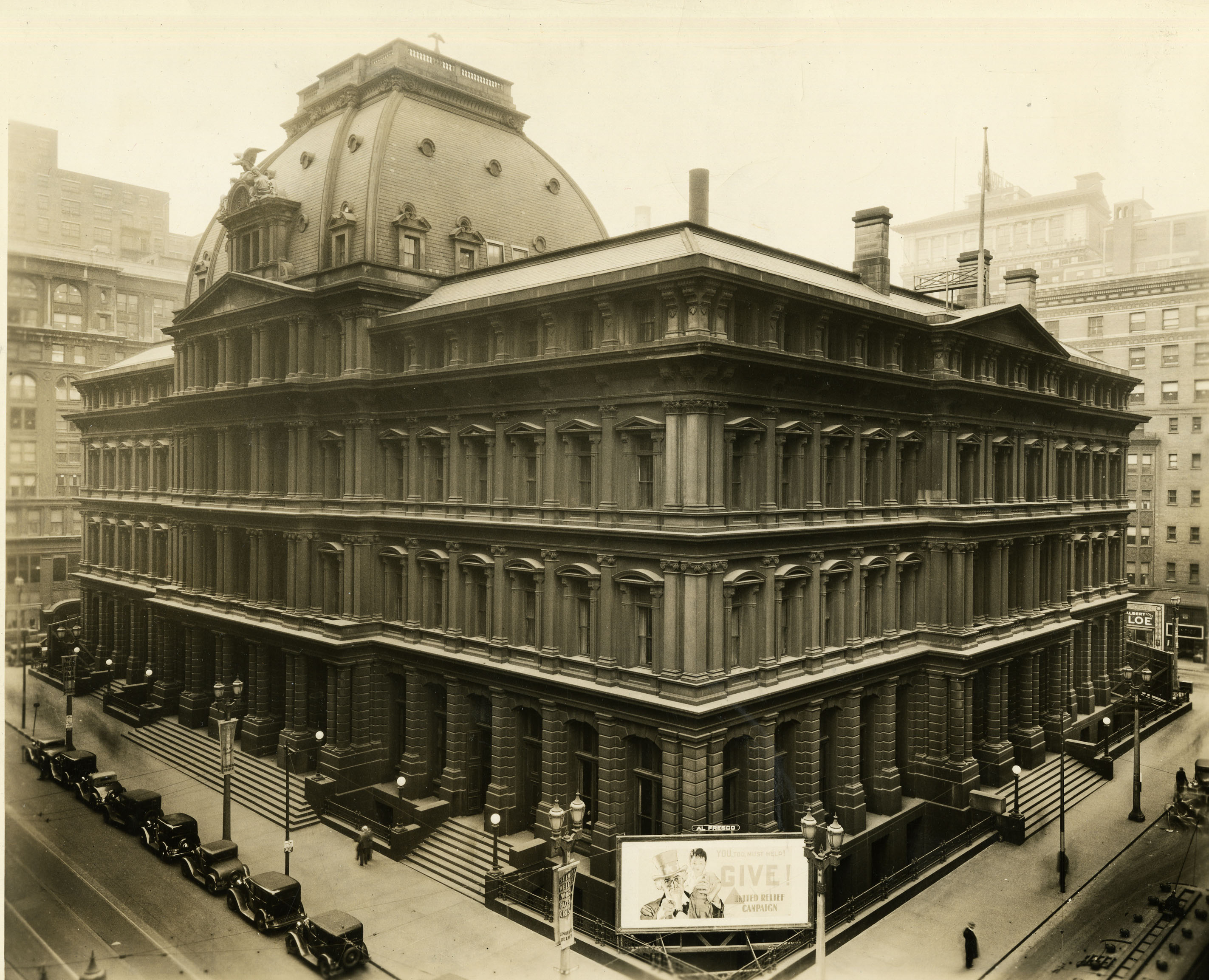
| The Old Post Office in the late nineteenth century Emil Boehl collection |
St. Louis Globe-Democrat, 1934 |

In accordance with the design of the general Government to build a new Custom House and Post-Office in St. Louis, the block bounded by Eighth and Ninth Streets, and Olive and Locust, was condemned and purchased in the autumn of 187l. The work of excavating soon commenced, and the building proceeded upon plans and specifications adopted for public buildings by the chief architect at Washington. Some difficulty was experienced in getting a proper foundation, but this was finally overcome, and the foundation was laid for a structure to cover the entire square. The foundations and walls of the basement are laid of red Missouri granite ; the superstructure, the walls of which are now up for the first story, are of gray granite, from Maine. The basement communicates with the tunnel, giving extraordinary facility for the handling of mails. The erection is under the superintendence of Thomas Walsh, architect.
The entire estimated cost. is $4,000,000. The building will be the largest in the city, and though somewhat bizarre in style, and of the stereotyped plan adopted for public buildings of its class, is justly regarded as a considerable acquisition to the architecture of the city. The selection of the location is only another evidence of the westward match of improvement in St. Louis. The building, as it will appear when finished, is shown very clearly on plate 21.

Pictorial St. Louis
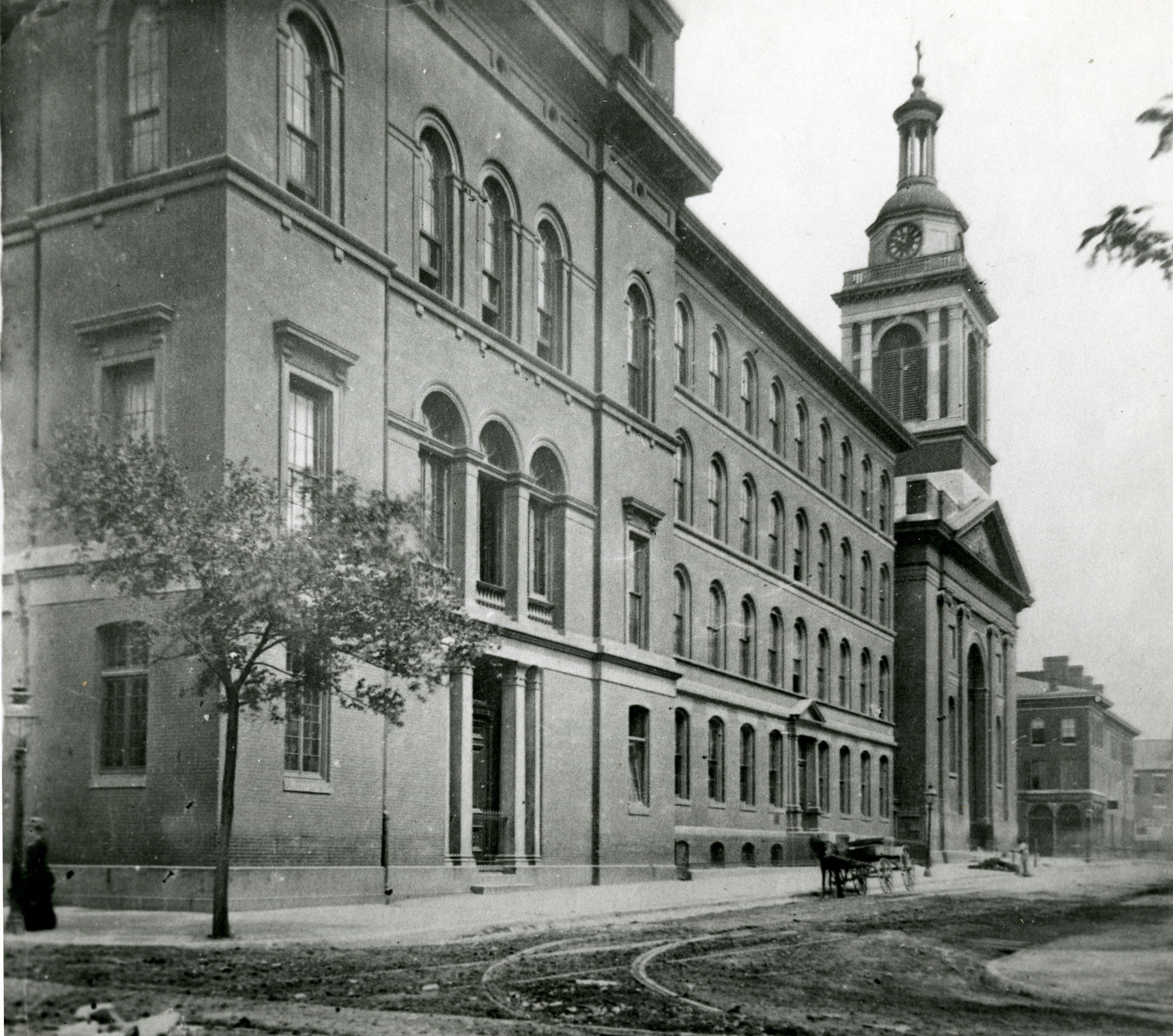
| View from Washington and Ninth |

This noble institution of learning, one of the oldest in the State and the oldest in the city, was founded in 1829. Previous to this a Mr. Donnelly had made a gift of a piece of land to Bishop DuBourg, and the latter had given it to the members of the Society of Jesus for school purposes. This property extended along Ninth Street. from Washington Avenue to Christy Avenue, and was of little value. It now forms the eastern part of the large square on which stand the University, the church, and the other buildings connected with them, and has had subsequent additions made to it by purchase. Through the efforts immediately of the late Rev. Charles Van Quickenborne, assisted and encouraged, as he was, by the labors of the first faculty, Rev. P. J. Verhagen, John Elet, and Peter J. DeSmet, the sum of four thousand dollars was subscribed by the citizens of St. Louis, then numbering but six thousand persons, and a building forty by fifty feet was erected, which was occupied as a school on the 3rd of November, 1829. Two years later an addition was made on the eastern side to accommodate the boarding students, and again in 1833, a still further addition was made on the west side. The entire building at that time stood on the Christy Avenue side, a hundred and thirty-two feet in length, fronting toward the road that is now called Washington Avenue. Over the door, in black letters on a white ground, was the simple inscription, still remaining, "St. Louis University." In February, 1833, the institution was incorporated by the Legislature of the State of Missouri, and fully empowered to confer academic and literary degrees. It was then considered, very justly, too, as a grand affair, architecturally imposing, and as the representative of the liberal education of the city. Here it was that Daniel Webster was entertained, under the locust trees, when he visited St. Louis, and here, too, Dickens and other notabilities were brought to scrutinize and admire. In 1836, the fourth building was erected, eighty by thirty feet, on the Washington Avenue side. This was used for the accommodation of a fine philosophical and chemical apparatus purchased from the College of St. Acheuil, in France, for the cabinet of natural history, and in part as a church. Four years later, or in 1840, the beautiful and spacious edifice, the Church of St. Francis Xavier, was commenced, and completed in two years. It has a frontage of sixty-seven feet on Ninth Street at the corner of Christy Avenue, and a depth of one hundred and twenty-seven feet, extending back to the University. The basement was fitted up and used as a free school, until the number of scholars reached as high as five hundred, when the crowding was thought to be detrimental to the health of the children, and another new building was put up for the purpose. This is a plain three-story brick, fronting on Christy Avenue, in line with but not adjoining the University. The rooms of the third floor, comfortable and well ventilated, are used as dormitories for the junior students.
A view of the pile with its enclosed court, as it existed in 1841, has been preserved to us in the pages of an illustrated publication of that day. The point of sight is from the southwest, showing the church in the foreground, the University stretching in a long line to the westward, the building on the Washington Avenue side, and the spacious grounds of the interior embelIished with trees. When the medical medical department was organized, another structure was added on the western line of the Washington Avenue side. Since the removal of this department to the handsome building, corner Seventh and Myrtle Streets, the building has been and is now occupied as dormitories fur the laborers about the establishment.
A ninth building was put up in 1851 , and in 1854 the principal structure of the series was erected on the corner of Ninth and Washington Avenue. This is sixty feet in front on Ninth Street, with a depth of one hundred and thirty feet on Washington Avenue, and is three stories in height. It is of pressed brick, with massive walls, and just enough exterior ornamentation to relieve the eye. It contains a chapel and hall for the senior students on the ground floor, two large rooms for the library, and the museum on the second floor, and on the third floor one of the finest exhibition halls in the country, certainly the finest in the city of St. Louis. In its interior measurement it is 113x55 feet, richly ornamented and frescoed. The seating capacity is probably greater than that of any other public hall in the city, and its accoustic properties far superior to anything in the West. Even when filIed, a boy's voice on the stage is distinctly heard in any part of it. Looking upward at the magnificent expanse of slightly arched ceiling, the contour unbroken by pendent chandeliers, the eye takes ill a most attractive sight the rich frescoes with harmonious tints at the sides. The stage has a striking drop curtain and stage accessories, suitable for the oratorical and lyrical exercises of the boys, who have here a field calculated to draw out all their powers.
The library is the rarest in the West, comprising in all some 25,000 volumes, taking in a full range of the ancient classics and of English literature, travels and history, English and French fiction and essays, moral philosophy, architecture and the arts, science, theology, and the public records of most of the modern nations, besides many miscellaneous and curious volumes, such as are rarely found, or indeed never met with elsewhere. Besides the books, are bound volumes of the leading magazines and many of the newspapers, extending back, in many instances, to the first copies issued. There is the famous "Doomsday Book," presented by the English Government, in one hundred and eleven volumes, with an index. The "Acta Sanctorum," in sixty volumes, from the beginning down to 1840. An "English Universal History," by a society of English gentlemen, in sixty volumes. A "Documentary History of New York," in ten volumes, with an index, now very are and valuable. "Schoolcraft's Indian Tribes," a work now so rare as to have no stated value. A "Monographie de la Cathedra Ie De Bourges," of which there are only two in America, the other being in the possession of the Smithsonian Institution, at Washington. Both these copies were presented by Father De Smet. It is richly colored by hand, contains much valuable information relating to the decorative art, and was published in Belgium, at the price of 2000 francs per copy. There is a "Theological Dictionary," by Angelas Clavasis, printed at Alcot, July 4, 1490, another work printed in 1478, and another in 1499; a copy of the "Sibyline Oracles," printed in Greek and Latin, in 1599 "Bundy's Roman History." "Swanton's Zoological Illustrations," the coloring by hand, and very perfect. "Church History," by Eusebius, in Greek and Latin; and "Pugin's Glossary of Ecclesiastical Ornaments," a work remarkably exhaustive and elaborate. The collections in the departments of mathematics, astronomy and architecture, are very full. The latter is especially rich, containing numbers of such works as "Carter's Ancient Architecture of England," and "Monuments of Art and Architecture of alI Ages," these latter being enriched by detailed drawings, which attest the highest artistic skilI, and profuse expenditure in their production.
Perhaps the most unique, and the rarest of the ancient folios, is an "Atlas of the World," by Johannes Blaev, printed at Amsterdam, in 1662. It is in thirteen volumes, bound in vellum, printed in Latin, on heavy fine paper. The whole of the known world is exhibited in a series of elegantly colored maps, upon a scale that permitted the laying down of each little hamlet. In England, for instance, each county is delineated upon a scale of nearly an inch to the mile, and each town, or even noted building, is located. The letter press in connection with it is clear and fine, and the ink of superior quality. The history of each subdivision is given, with the facts relating to its principal buildings, its leading families, and fac similies of their armorial bearings done in colors, the tints of which look as fresh as when first laid on. It is remarkable that our own age has produced nothing so complete or as beautiful in this department of knowledge. The edition of this book is said to have been but five hundred, but very few of which probably exist at the present time.
Another curious object is a "new solar globe," which, as the enterprising publisher announces, "contains alI the late discoveries, down to the year 1640." There is a picture of the first church built in St. Louis, in 1770, and of the brick church which succeeded it in 1819. Both of these were in turn succeeded by the cathedral, on Walnut and Second Streets. Going back before the art of printing, there are manuscripts, most of them of the gospels, that exceed in beauty and clearness anything that printing can now produce.
The museum, on the same floor, is especially rich in Indian curiosities, many of which were gathered by the early fathers, and others sent to them by former pupils who have generously remembered their alma mater, in almost all of the departments of the museum. There is, among the printed and written curiosities, a "Missouri Gazette," of 1815; a New York "Postboy and Gazette," of 1770; curious manuscripts dating back before the art of printing; and the original autograph copy of General Lee's last order to the army of northern Virginia, announcing the surrender. There are also the skulls and antlers of deers inextricably fixed together, as they had undoubtedly been in a fight, in which both had perished in this singular manner. Such articles, with petrifactions, coins, stones, woods, skulls, carvings, and mementoes of persons variously distinguished, make up a collection that is full of interest, and that is probably the most authentic of any in this country that compares with it in size.
The last building of this stately pile, the eleventh in point of number, closing up the Ninth Street side with a continuous line, was erected in 1863. It is 80 feet on Ninth Street by 40 feet in depth, specially constructed with a view to abundant light and air. Of the four stories, the first three are used as class rooms, four rooms to the floor, each fitted up with the most modern improvements for the convenience of the students. The fourth floor contains the dormitories of the senior students, and also the Philalethic Hall, where debates are conducted by the boys, under the supervision of one of the professors, and under strict parliamentary rules. The walls are adorned with the portraits of ancient orators of all centuries, and the fresco, by Matt. Hastings, a former pupil, is in appropriate design.
This institution, so well fitted to bestow a liberal education upon its pupils, to cultivate each faculty, and bring out the best development, has enjoyed uninterrupted prosperity from the first, and has trained some of the brightest minds of the nation. The total number of students, as show by the catalogue of 1874-75, was 353, the larger number, as would be expected, from Missouri, but many from other and from distant States. The board of trustees, at present, consists of Rev. L. Bushart, president; Rev. P. J. Leysen, chancellor; Rev. W. H. Hill, secretary; Rev. J. H. Erley, treasurer. The faculty comprises a list of names severally distinguished in various departments. Among the literary institutions of our country, none are managed in a more self-sacrificing spirit; none are richer in associations of the past; noe more worthy of honor.

Pictorial St. Louis

This beautiful and stately edifice, situated on the corner of Ninth and Green Streets, was commenced and prosecuted to completion in 1840-42, and is one of the oldest temples of worship in St. Louis. It is of the Romanesque style of architecture, and built with a large and roomy basement. which, for many years, was used as a free school for the parish. It is a substantial brick structure, fronting 67 feet on Ninth Street and 127 feet on Green, extending back to the eastern end of the old College building. It is capable of seating 3000 persons, and of late years has been found not any too large for the accommodation of the members of the church in this parish. It is artistically frescoed on the interior, which is rendered very imposing by the rows of fluted columns which support the galleries. It is decorated with some of the work of the most renowned artists of Europe, whose masterpieces are to be found hung to its walls. Many of them, paintings representing biblical subjects and scenes from the life of Christ, are very valuable, and could not be replaced with money. The officiating priests are members of the Society of Jesus, and professors in the St. Louis University.

Pictorial St. Louis

ST. FRANCIS XAVIER'S SCHOOL is situated on Green Street, between Tenth and Eleventh, and is a three-story brick building, valued at about $5,000. This school was for many years in the basement of the church, but the increasing number of scholars demanded more spacious apartments, and about 1850 this structure was erected. Both male and female here receive instruction, but in separate apartments, secular teachers having charge of the former, and the Sisters of Loretto of the latter. About 415 boys and 280 girls are in daily attendance upon these schools. The different branches of a common English education are taught. Many children who have commenced in this and other parochial schools have made bright records in the higher classes of the University.

Pictorial St. Louis
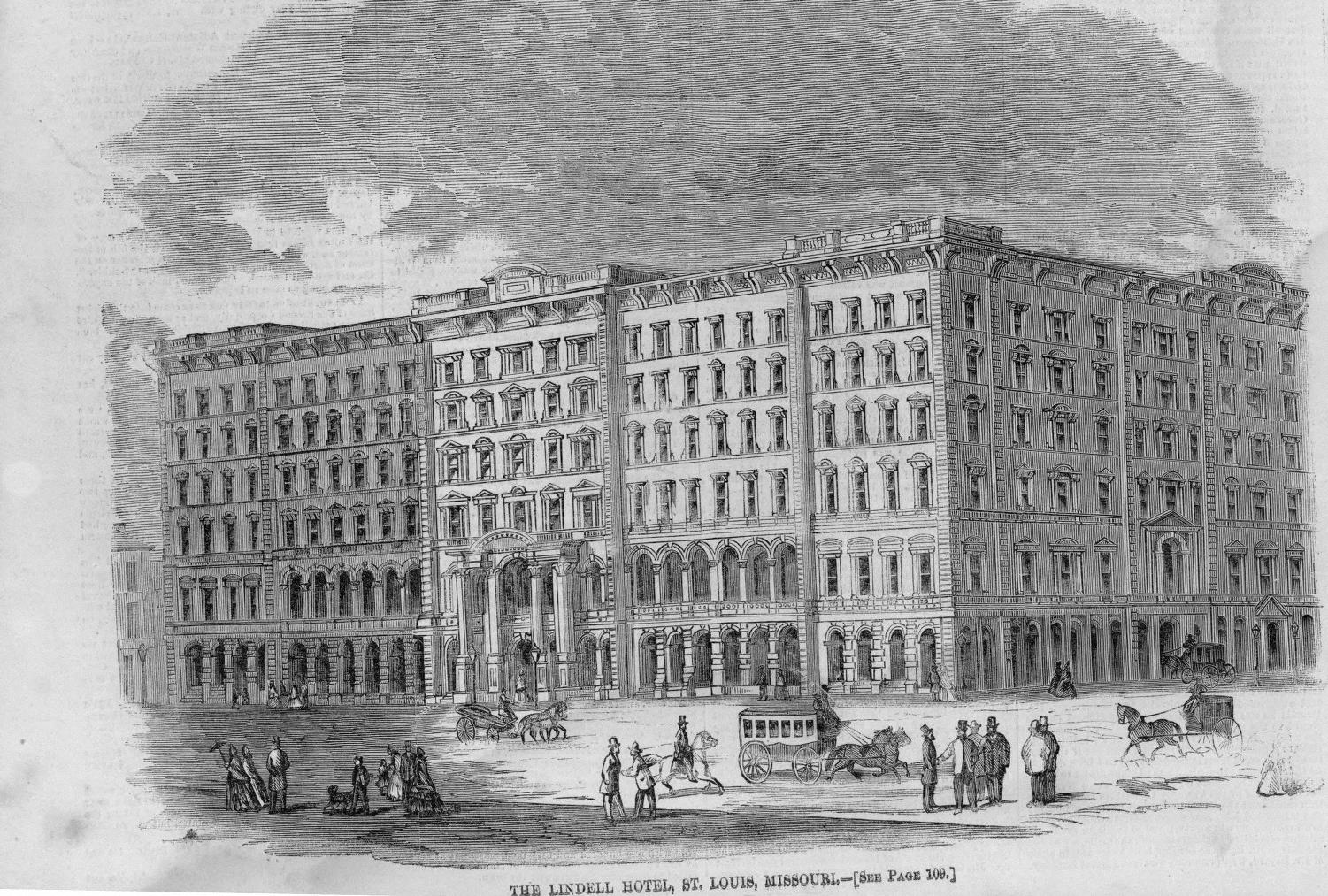
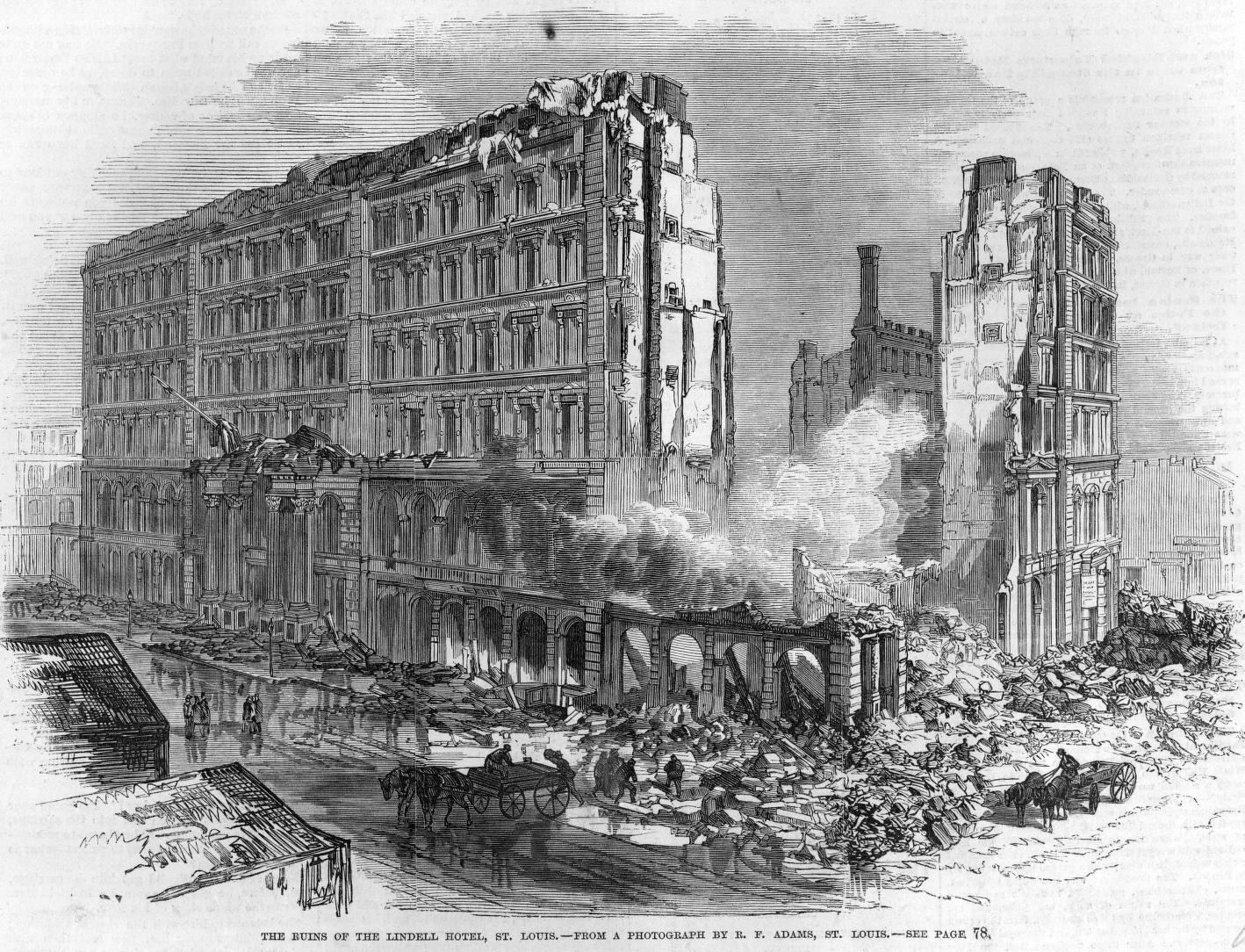
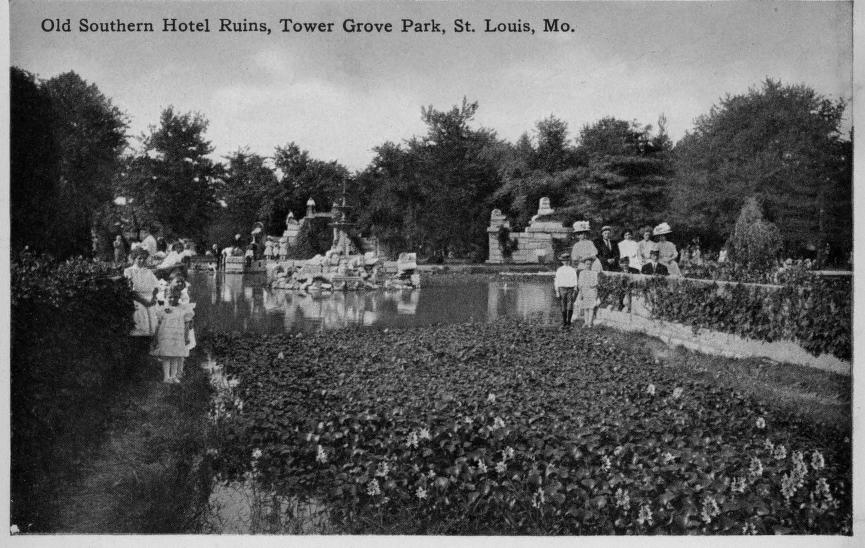
| Images from the St. Louis Views collection of the original Lindell Hotel and its ruins in Tower Grove Park (see Plate 94) Its destruction has often been confused with that of the Old Southern Hotel (see Plate 24) |

About the time that business began to move from Main to Fifth Street, a project was set on foot for rebuilding the Lindell Hotel. Since the destruction of the old house by fire [in 1867], property in that neighborhood had been on the down grade, and a handsome bonus of $100,000 was contributed by near and adjacent property to assist in the building. On the 28th of September, 1874, the new house was opened for business, by Felt, Griswold & Co., Mt. Felt having been one of the lessees of the old Lindell. It has a capacity for about 600 guests, and was furnished at a cost of about $180,000. It is built of gray sandstone, and, although not as extensive as the old building which it replaces, enjoys many advantages and conveniences over its predecessor. Its decoration and appointment are florid in style, and the house has enjoyed a first-class reputation since it was opened. Mr. Felt died in the summer of 1875, and a new firm was formed under the name of Griswold, Clement & Scudder, composed of Jas. L. Griswold, H. S. Clement and Charles Scudder. The new firm took charge on the 1st of September, 1875.
The growth of grand business structures all around this location would seem to promise that the house will yet be built to cover the entire block.

Pictorial St. Louis